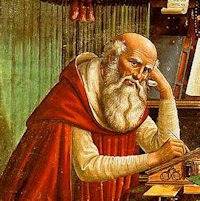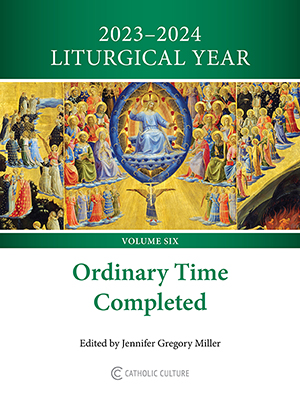Ordinary Time: November 26th
Tuesday of the Thirty-Fourth Week in Ordinary Time
Other Commemorations: St. Sylvester, Abbot (RM); St. Leonard of Port Maurice, Priest (RM)
» Enjoy our Liturgical Seasons series of e-books!
The Roman Martyrology includes in commemoration:
—St. Sylvester, Abbot (1177-1267). He was the son of a lawyer and had also studied law before becoming a canon in his native town of Osimo. He was a zealous and fervent priest. His determination to retire into solitude was caused by the sight of the decomposing corpse of a friend. He at first lived as a hermit at Grotta Fucile, and then on Monte Fano where followers came to join him. He gave them the habit and Rule of St. Benedict together with certain other customs which reflect his own aspirations and the devotional tendencies of his day. He died in 1267 at the age of ninety.
—St. Leonard of Port Maurice, priest (1676-1751). St. Leonard was a confessor, missionary and ascetic writer. He was part of the Riformella, a branch of the Franciscans, and spent his life giving missions in Tuscany, Central and Southern Italy, and Corsica. He advocated in particular, the devotion of the Way of the Cross, and erected the celebrated stations in the Colosseum. His writings are numerous, consisting of sermons, letters, ascetic treatises, and books of devotion. —New Catholic Dictionary
St. Sylvester
 Sylvester, of the noble Gozzolini family, was born in Italy in 1177. After making a distinguished record at the universities of Bologna and Padua, he was made a canon at Osimo, his native city. His inclination toward the contemplative life was strengthened by the sight of the dead body of a once handsome relative. "I am what he was," said Sylvester to himself, "and I will also be what he is."
Sylvester, of the noble Gozzolini family, was born in Italy in 1177. After making a distinguished record at the universities of Bologna and Padua, he was made a canon at Osimo, his native city. His inclination toward the contemplative life was strengthened by the sight of the dead body of a once handsome relative. "I am what he was," said Sylvester to himself, "and I will also be what he is."
After the funeral services, the words of our Lord kept ringing in his ears, "If anyone wishes to come after Me, let him deny himself, and take up his cross and follow Me" (Matt. 16:24). At the age of 50 he resigned his post and became a hermit. Many disciples came to him, and these he organized under the rule of St. Benedict. After his death the order became known as the Sylvestrines, especially noted for their spirit of poverty. Their founder died at the age of 90.
The members of his Order wear a Benedictine habit, Turkish blue in color. Today there remain seven Sylvestrine monasteries in Italy and several mission houses in Ceylon and in the United States. Dom Gueranger writes on the significance of St. Sylvester: "God often brings the world to those who flee from it, as Sylvester Gozzolini among others experienced. In the thirteenth century, the world, all in admiration at the sanctity and the eloquence of the new Orders, seemed to have forgotten the monks and the desert. God, who never forgets, led his elect silently into solitude, and the wilderness began again to rejoice and flourish like the lily; strength was restored to the weak hands and feeble knees of the sons of the cloister. The austerities of olden days and the fervor of prolonged prayer were revived at Monte Fano, and extended into sixty other monasteries; the new religious family of the Sylvestrians was approved by Innocent IV in 1247. Though originated seven centuries after St. Benedict, and distinguished from the elder families by its blue habit, it claims the Patriarch of Cassino for its legislator and father."
—Excerpted from The Church's Year of Grace by Fr. Pius Parsch
Patronage: in Italy: Fabriano and Osimo
Highlights and Things to Do:
- Read more about St. Sylvester:
- Find out more about the Sylvestrines. Wikipedia has more information.
- St. Sylvester's relics are located in the monastery church of Monte Fano in Fabriano, Italy
St. Leonard of Port Maurice
 St. Leonard was born on December 20, 1676 in Porto Maurizio, Italy. He was given the name Paul Jerome Casanova by his father, Domenico Casanova, a sea captain, and his mother, Anna Maria Benza.
St. Leonard was born on December 20, 1676 in Porto Maurizio, Italy. He was given the name Paul Jerome Casanova by his father, Domenico Casanova, a sea captain, and his mother, Anna Maria Benza.
When he was 13, he was placed with his uncle Agostino to study for a career as a physician, but when the boy decided against medicine, his uncle disowned him. He then began to study at the Jesuit College in Rome.
On October 2, 1697, he joined the Franciscans of the Strict Observance and took the name Brother Leonard. He was ordained in Rome in 1703. He taught for a while, and expected to become a missionary in China, but a bleeding ulcer kept him in his native Porto Maurizio for the four years it took for him to recover and regain his strength.
In 1709, St. Leonard of Port Maurice was sent to Florence where he preached in the city and nearby region. A great preacher, he was often invited to visit and preach in other areas. He worked to increase devotion to the Blessed Sacrament, Sacred Heart, Immaculate Conception, and the Stations of the Cross.
One of his accomplishments was to set up the Stations of the Cross in over 500 different places, including the Colosseum. He was sent as a missionary to Corsica by Pope Benedict XIV in 1744 and restored discipline to the holy orders there, but local politics greatly limited his success in preaching.
He returned to Rome exhausted, and died that night on November 26, 1751 at the monastery of Saint Bonaventure in Rome.
From St. Leonard of Port Maurice, a Modern Catholic can find an example of great servitude and spiritual stamina. One may look at how he lived his life with Christian perseverance, always seeking out opportunities to build the Kingdom of God, until his death.
—Excerpted from Catholic News Agency
Symbols and Representation: man in Franciscan habit with the Blessed Virgin Mary
Patronage: clergy; missionaries; parish missions; Imperia, Italy
Highlights and Things to Do:
- Read more about St. Leonard:
- St. Leonard's relics are kept in the high altar of the church of St. Bonaventure monastery in Rome, San_Bonaventura_al_Palatino. See also Roma Segreta.








